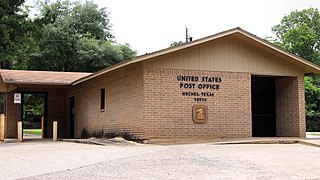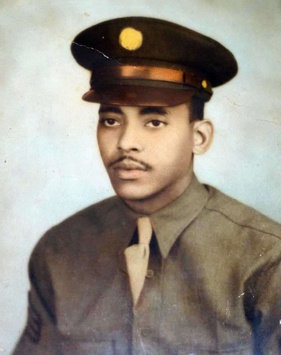The Tuskegee Airmen was a group of primarily African American military pilots and airmen who fought in World War II. They formed the 332nd Fighter Group and the 477th Bombardment Group (Medium) of the United States Army Air Forces (USAAF). The name also applies to the navigators, bombardiers, mechanics, instructors, crew chiefs, nurses, cooks, and other support personnel. The Tuskegee airmen received praise for their excellent combat record earned while protecting American bombers from enemy fighters. The group was awarded three Distinguished Unit Citations.

Beaumont is a city in the U.S. state of Texas. It is the seat of government of Jefferson County, within the Beaumont–Port Arthur metropolitan statistical area, located in Southeast Texas on the Neches River about 85 miles (137 km) east of Houston. With a population of 115,282 at the 2020 census, Beaumont is the largest municipality by population near the Louisiana border. Its metropolitan area was the 10th largest in Texas in 2020, and 130th in the United States.
Apple Springs is an unincorporated community in Trinity County, Texas, United States. According to the Handbook of Texas, the community had a population of 185 in 2000. It is located within the Huntsville, Texas micropolitan area.

The economy of the State of Texas is the second largest by GDP in the United States after that of California. It has a gross state product of $2.694 trillion as of 2023. In 2022, Texas led the nation with the most companies in the Fortune 500 with 53 in total. As of 2023, Texas grossed more than $440 billion a year in exports, more than double the next highest state California.

Neches is an unincorporated community and census designated place (CDP) in east central Anderson County, in the U.S. state of Texas. According to the Handbook of Texas, the community had a population of 175 in 2000. It is located within the Palestine, Texas micropolitan area.

Iola is a city in Grimes County, Texas, United States, on Farm to Market Road 39 and the Burlington-Rock Island Railroad, at the headwaters of Ragan Creek in northwestern Grimes County. As of the 2020 census the population was 311.
Westfield is an unincorporated community in Harris County, Texas, United States, located along Interstate 45 and the Union Pacific Railroad nineteen miles (30 km) north of Downtown Houston.

Clodine is an unincorporated community in Fort Bend County, Texas, United States. According to the Handbook of Texas, the community had a population of 31 in 1990. It is located in the Greater Houston metro area.
The Beaumont, Sour Lake and Western Railway was an 85-mile (137 km) railroad that ran from Beaumont, Texas to Gulf Coast Junction in Houston. It passed through small southeast Texas communities such as Hull, Kenefick, and Huffman. As part of the Gulf Coast Lines system, the road was eventually merged into the Missouri Pacific Railroad in 1956, which in turn was merged into the Union Pacific Railroad in 1982. The Union Pacific still makes heavy use of the route.

The Galveston Bay Area, also known as Bay Area Houston or simply the Bay Area, is a region that surrounds the Galveston Bay estuary of Southeast Texas in the United States, within Houston–The Woodlands–Sugar Land metropolitan area. Normally the term refers to the mainland communities around the bay and excludes Galveston as well as most of Houston.
Sacul is an unincorporated community in Nacogdoches County, Texas, United States. According to the Handbook of Texas, the community had an estimated population of 170 in both 1990 and 2000.
Bleiblerville is an unincorporated community in northern Austin County, Texas, United States. According to the Handbook of Texas, its population was 71 in 2000. It is located within the Greater Houston metropolitan area.

Umbarger is a census-designated place in Randall County, Texas, United States. According to the Handbook of Texas, the community had an estimated population of 327 in 2000. The community is part of the Amarillo, Texas Metropolitan Statistical Area.

The Texas oil boom, sometimes called the gusher age, was a period of dramatic change and economic growth in the U.S. state of Texas during the early 20th century that began with the discovery of a large petroleum reserve near Beaumont, Texas. The find was unprecedented in its size (worldwide) and ushered in an age of rapid regional development and industrialization that has few parallels in U.S. history. Texas quickly became one of the leading oil-producing states in the U.S., along with Oklahoma and California; soon the nation overtook the Russian Empire as the top producer of petroleum. By 1940 Texas had come to dominate U.S. production. Some historians even define the beginning of the world's Oil Age as the beginning of this era in Texas.
Bracken is an unincorporated community in Comal County, Texas, United States. According to the Handbook of Texas, the community had a population of 76 in 2000. It is included in the Greater San Antonio area.
East Tempe is an unincorporated community in west central Polk County, Texas, United States. The community, on Farm to Market Road 350, is 75 miles (121 km) north of Houston. The community, on the periphery of Livingston, was named after the East Tempe Creek, a creek which flows through the area.
Lawrence is an unincorporated community in Kaufman County, located in the U.S. state of Texas. According to the Handbook of Texas, the community had a population of 279 in 2000. It is located within the Dallas/Fort Worth Metroplex.

Theodore P. Johnson, Jr. was an American military serviceman who served during World War II and was a Documented Original Tuskegee Airman.

Sgt. Major Thomas Ellis from San Antonio, Texas, was a member of the famed group of World War II-era African-Americans known as the Tuskegee Airmen. He served in the 301st Fighter Squadron and the 332nd Fighter Group during WWII.
Graham "Peepsight" Smith † was an U.S. Army Air Force officer and combat fighter pilot with the 332nd Fighter Group's 99th Fighter Squadron, best known as the Tuskegee Airmen. He was a member of Tuskegee Airmen's fourth-ever aviation cadet program and one of the 1,007 documented Tuskegee Airmen Pilots.












